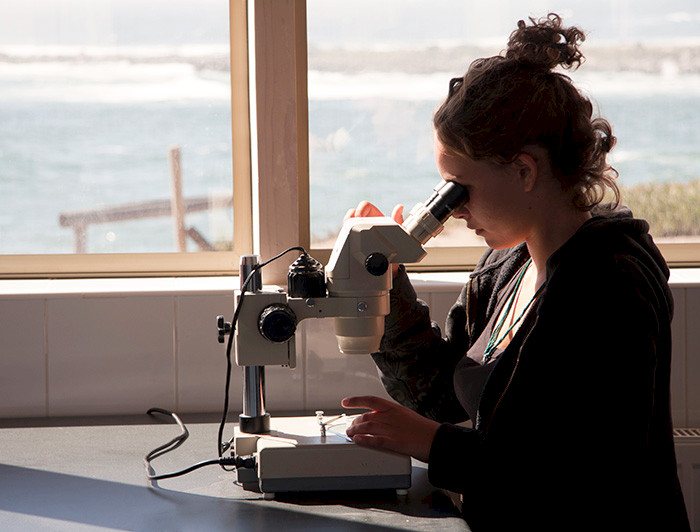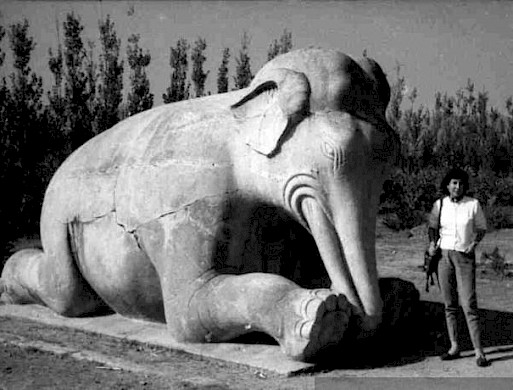
New Topics Being Researched at UC
A fog map, the biodiversity in Patagonia, China and Chile relations, and the gender pay gap, are some of the topics of 33 projects of young UC researchers, selected in the recent call for the Fondecyt Iniciación competition.

photo_camera The topics of the 33 projects selected in the last call of the Fondecyt Iniciación competition are varied. (Photo: Karina Fuenzalida)
The competition "Fondecyt de Iniciación a la Investigación" (Research Initiation Fondecyt), of the National Agency of Research and Development (ANID Spanish acronym), is the first big boost for researchers starting their career.
According to the last call results, announced at the end of October, 33 UC projects were selected. As stated by the Director of UC Research, María Elena Boisier, "Initiatives such as this support young researchers, who through new views and proposals, and through the science of excellence, provide innovative solutions to current problems."
But who are these researchers? What are their topics of study? What motivates them? How do they project their research?
Here are four of the selected projects and the stories behind them. (See the complete list here, in Spanish)
Fog: The Water Source of the Future
Video: Fog at UC Atacama Station - Images captured by Camilo del Río.
Seeking alternative sources of water is necessary for the context of drought, desertification, and climate change. In the driest desert in the world, "where every drop is like gold" - as geographer Camilo del Río says - fog can be the answer. "It could allow the development of small-scale productive activities and be a sustainable option for providing water to small localities," he explained.
The pioneering studies on fog began at the UC Institute of Geography in the eighties, promoted by faculty member Pilar Cereceda, and were continued by, among others, Professor Pablo Osses.
The UC Atacama Station is the university's research base in Alto Patache, 60 km south of Iquique, north of Chile. It is located in a "fog oasis," and its symbol is the "fog-catchers." These are structures that collect drops of water from the camanchaca -a thick fog on Chile and Peru's coasts- that covers the territory.
The fog-catchers collect several liters of water that can be used both for human consumption and productive activities.
Here is where the idea of creating a fog map of northern Chile came to be. "This will allow us to know where the fog is and how much water can be obtained, both for communities and decision-makers," said Camilo del Río. He is also a member of the Atacama Desert Center and the UC Water Law and Management Center.
The project is called "The space-time variability of coastal fog in northern Chile (18° - 30°S): Multi-factorial and multi-scale analysis for constructing the water fog map."
Through this map of the entire northern coast of Chile, from Arica to Valparaiso, Camilo del Rio will seek to determine the frequency of fog, using meteorological data and satellite images from the last 25 to 30 years. This map will make it possible to monitor the fog's distribution in the territory, both for a day and for each season of the year.
Although the data will be presented as averages and on a scale of 1 square km, the map will show:
- Trends.
- The increase or decrease of fog in certain areas.
- The produced effects by phenomena such as the Pacific anticyclone or sea temperature (which changes with the currents of El Niño or La Niña).
- And detecting anomalies or factors involved in their formation.
The second part of the project is the local scale. Aspects such as the fog "thickness," the start and "ceiling" of the cloud, and its impact on the territory, are challenging to determine with satellite images, so going on-site is essential.
For this reason, the researcher defined three control or monitoring points:
- The UC Atacama Station, in the Tarapacá Region, represents the super arid areas of Chile.
- The Pan de Azúcar National Park, in the Antofagasta and Atacama Regions, reflects the dry regions of Chile.
- In the Coquimbo Region, the Fray Jorge National Park is a sample of Chile's semi-arid areas.
"Water is a vital element. I dream that someday fog can be used to supply part of human consumption and make agriculture and even reforestation possible. There are experiments of hydroponic crops with fog water from the Faculty of Agriculture & Forestry. I hope that it also serves to highlight the ecosystem services provided by these territories," said Camilo del Río.
He even goes one step further: "Most of the protected areas of our country are in the south, few are in the north, even less on the coast. For me, it would be a dream if the area from Alto Patache to Cerro Guanacos, on the Tarapacá coast -with unique ecosystems and also heritage landmarks- were protected."
Protecting Patagonia's Biodiversity

Nature does not only offer beautiful landscapes. It also provides us with clean water and food, and it regulates the climate and diseases. It allows us to develop economic and recreational activities, among many others, all known as "ecosystem services."
In Chile, famous researchers have led these studies, such as:
- Juan Carlos Castilla, National Applied Science Awards 2010.
- Juan Armesto
- and Pablo Marquet, all faculty members of the Faculty of Biological Sciences.
For years, they have been promoting to established protected-areas to preserve biodiversity and its many essential benefits for human well-being.
María José Martínez, a postdoctoral researcher of the Faculty of Biological Sciences, CAPES UC and IEB, was captivated by this topic.
Her studies regarding nature's services and their adequate decision-making evaluation have led her to be published in leading international journals. Her work has become an international reference, which earned her the L'Oréal Chile-UNESCO For Women in Science Award in 2019.
And this is also the topic for her project selected by the Fondecyt Iniciación competition: "Priority setting for biodiversity and cultural ecosystem services by integrating terrestrial and marine systems in Patagonia."
"I feel Patagonia is not receiving the importance that it should be given. It must be protected from the effects of climate change and human activities. Although more than half of the fjord area has been protected, we do not have management plans. There is aquaculture in marine protected areas, and we do not know the effects of massive fish escapes. There is also tourism. We need to start making economic activities compatible with sustainability," said the researcher. "We have failed to safeguard this biodiversity."
Inspired by her conviction, her project consists of mapping "hot spots" or points of the ecosystem and cultural services in the Chilean Patagonia, from the Reloncavi Sound to Cape Horn.
The aim is to identify terrestrial or maritime locations that provide ecotourism, cultural identity, recreation, and scenic beauty, and obtain information on biodiversity.
"The objective is to highlight the importance of these multiple benefits," she explained. And how? By using social media. It's about using the same photos that people upload to make a map. "From here, it is possible to obtain a lot of information, not only from the places but also from the emotions that these generate in people," explained the researcher.
The objective is to:
- identify priority areas and actions in sea-land ecosystems,
- conservation of biodiversity and cultural ecosystem services,
- avoid the negative impacts that affect these systems in Chilean Patagonia.
"With all this information, it is possible to prioritize and carry out an adequate evaluation for decision-making and to strengthen conservation management in Patagonia," concluded María José Martínez.
More Women in Science, the Solution to Narrowing the Pay Gap?
In Chile, only one out of every four students enrolled in Science, Technology, Engineering, and Mathematics (STEM) programs are women (Read more about this topic). The trend is not exclusive to our country. In the United States, only 19.2% of people with technology or engineering degree are women.
Since salaries in this area are usually high, career choice is seen as one factor that would explain the gender pay gap. And that is why several countries, including Chile, are making efforts to encourage more women to study these disciplines, such as lowering admission scores, among other incentives.
But why are women not enrolling in these degree programs? And if they do, what is the real impact?
These are some of the questions that led Josefa Aguirre, a faculty member from the School of Government, to her project to Fondecyt Iniciación, "Understanding the roots of the gender gap in the labor market."
This proposal was born from her previous work, together with Ana María Montoya, a researcher from Universidad de Chile, and Juan Matta, from NYU.
The objective of the study is to understand the roots of gender gaps in the labor market. It seeks to determine to what extent promoting women's participation in male-dominated high-income fields can effectively reduce the wage gap.
"Our feeling is that it is not enough to study engineering to close the gap. We collected data on education, fertility, and income. Engineering and technology careers pay very well, but the pay gap is also higher. In the early years, the gap between male and female engineers is higher than in other careers. We ask ourselves what would happen if a woman engineer had studied something else. Or the other way around: what if a woman from another profession had entered an Engineering program," explained Josefa Aguirre.
"The first thing we want to know is the impact of having studied Engineering for these women. Not only in terms of income but also in terms of fertility and the probability of work. And try to understand the barriers that exist," said the commercial engineer, who holds a Doctorate in Economics and Education from Teachers College Columbia University.
The project will also take a very particular group as a case study: Those applicants who were on the verge of being admitted to an Engineering program and were also considering a career in social sciences and humanities.
"What we see is that for men who were admitted in an Engineering program, it makes a big difference in terms of salary, but not for women," she said. And added: "Our feeling is that women have a hard time getting into specific industries, which are still very male-dominated.
Another point to study is how the environments in which women are - school or college classmates, or family - can affect women's long-term outcomes and decision-making. Here networking is essential too, especially with other women.
These questions and intuitions are only the starting point for this researcher, who is undoubtedly passionate about women's insertion in the labor market.
Another aspect that calls her attention these days is how the Covid-19 pandemic has affected women from different careers and socioeconomic levels. What will happen to those women who have lost their jobs or have had to leave their positions to undertake domestic work and childcare? What are the social effects that all this entails?
Josefa Aguirre concluded: "A society where fewer women work also makes the country more sexist."
Cultural Diplomacy: Chilean Travelers in China

In the middle of the Cold War, when the world was divided between two great powers -the United States and Russia-, another giant also sought to play a role.
Through a program of "cultural diplomacy," China sought international legitimacy. The country issued a series of invitations to intellectuals and artists from the so-called "third world," including Chile, to visit the country and learn about the revolutionary experience of the so-called "new China."
Who were these Chilean travelers?; What was their journey like?; What impressions did they have?; What links did they develop?
These are some of the questions that haunt the mind of María Montt, a faculty member of the Institute of History and researcher of the UC Center for Asian Studies. And that led her to present the project "Cold War Travelers: cultural diplomacy and transnational networks between Chile and the People's Republic of China (1949-1979)".
"I am interested in learning the imaginaries that those travelers had, the stereotypes, many of them still in force today," said the researcher. And she added: "with knowledge, one can contribute to disarming these stereotypes.
Montt has an M.A. in Chinese Studies from the SOAS (School of Oriental and African Studies), University of London. She has written a series of publications about China, the Cold War, and the relationships between people or "unofficial" diplomacy.
The project focuses on how cultural aspects were part of the strategy of China's relationship with Chile and on the journey itself, as a space for exchange, production, and transmission of knowledge, generating a "map" of this journey. "My goal is to reconstruct this history of relationships between the two countries," said Maria Montt.
The travelers were very diverse. Among them are figures like the poet Ángel Cruchaga Santa María, who, as a result of his journey, wrote the book "Anillo de Jade. Poemas de China" (1959). There is also the poet, researcher, and cultural manager Tomás Lagos, and Olga Poblete de Espinoza, professor, and pioneer in the fight for women's rights and equality in Chile.
Another aspect of the research is building an archive of the relationships between Chile and China through books, travel chronicles, photographs, and other documents existing in libraries and private archives, including social media.
"It is very gratifying to have been awarded this fund. It is not only because of all the work involved but also because it allows us to have thesis writers and assistants, contributing to generating critical mass. You help generate knowledge. It's a way to give back to the university," said the historian.
And concluded: "This project opens the door to continue studying relationships between China and Chile, in other periods," always in light of recent questions, in which China is emerging as a world power.


